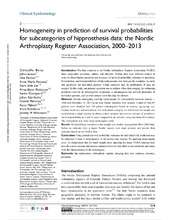| dc.contributor.author | Bartz-Johannessen, Christoffer | en_US |
| dc.contributor.author | Furnes, Ove | en_US |
| dc.contributor.author | Fenstad, Anne Marie | en_US |
| dc.contributor.author | Lie, Stein Atle | en_US |
| dc.contributor.author | Pedersen, Alma Becic | en_US |
| dc.contributor.author | Overgaard, Søren | en_US |
| dc.contributor.author | Kärrholm, Johan | en_US |
| dc.contributor.author | Malchau, Henrik | en_US |
| dc.contributor.author | Mäkelä, Keijo | en_US |
| dc.contributor.author | Eskelinen, Antti | en_US |
| dc.contributor.author | Wilkinson, Jeremy M | en_US |
| dc.date.accessioned | 2020-08-07T11:40:43Z | |
| dc.date.available | 2020-08-07T11:40:43Z | |
| dc.date.issued | 2019-07-10 | |
| dc.Published | Bartz-Johannessen CA, Furnes O, Fenstad F, Lie SA, Pedersen AB, Overgaard S, Kärrholm J, Malchau H, Mäkelä K, Eskelinen A, Wilkinson. Homogeneity in prediction of survival probabilities for subcategories of hipprosthesis data: The nordic arthroplasty register association, 2000?2013. Clinical Epidemiology. 2019;11:519-524 | eng |
| dc.identifier.issn | 1179-1349 | |
| dc.identifier.uri | https://hdl.handle.net/1956/23557 | |
| dc.description.abstract | Introduction: The four countries in the Nordic Arthroplasty Register Association (NARA) share geographic proximity, culture, and ethnicity. Pooling data from different sources in order to obtain higher precision and accuracy of survival-probability estimates is appealing. Nevertheless, survival probabilities of hip replacements vary between the countries. As such, risk prediction for individual patients within countries may be problematic if data are merged. In this study, our primary question was to address when data merging for estimating prosthesis survival in subcategories of patients is advantageous for survival prediction of individual patients, and at what sample sizes this may be advised. Methods: Patients undergoing total hip replacements for osteoarthritis between January 1, 2000 and December 31, 2013 in the four Nordic countries were studied. A total of 184,507 patients were stratified into 360 patient subcategories based on country, age-group, sex, fixation, head size, and articulation. For each patient category, we determined the sample size needed from a single country to obtain a more accurate and precise estimate of prosthesis-survival probability at 5 and 10 years compared to an estimate using data from all countries. The comparison was done using mean-square error. Results: We found large variations in the sample size needed, ranging from 40 to 2,060 hips, before an estimate from a single Nordic country was more accurate and precise than estimates based on the NARA data. Conclusion: Using pooled survival-probability estimates for individual risk prediction may be imprecise if there is heterogeneity in the pooled data sources. By applying mean-square error, we demonstrate that for small sample sizes, applying the larger NARA database may provide a more accurate and precise estimate; however, this effect is not consistent and varies with the characteristics of the subcategory. | en_US |
| dc.language.iso | eng | eng |
| dc.publisher | Dove Medical Press | eng |
| dc.rights | Attribution-Non Commercial CC BY-NC | eng |
| dc.rights.uri | http://creativecommons.org/licenses/by-nc/3.0/ | eng |
| dc.title | Homogeneity in prediction of survival probabilities for subcategories of hipprosthesis data: The Nordic Arthroplasty Register Association, 2000-2013 | en_US |
| dc.type | Peer reviewed | |
| dc.type | Journal article | |
| dc.date.updated | 2019-12-13T13:28:35Z | |
| dc.description.version | publishedVersion | en_US |
| dc.rights.holder | Copyright 2019 The Authors | |
| dc.identifier.doi | https://doi.org/10.2147/clep.s199227 | |
| dc.identifier.cristin | 1731345 | |
| dc.source.journal | Clinical Epidemiology | |

